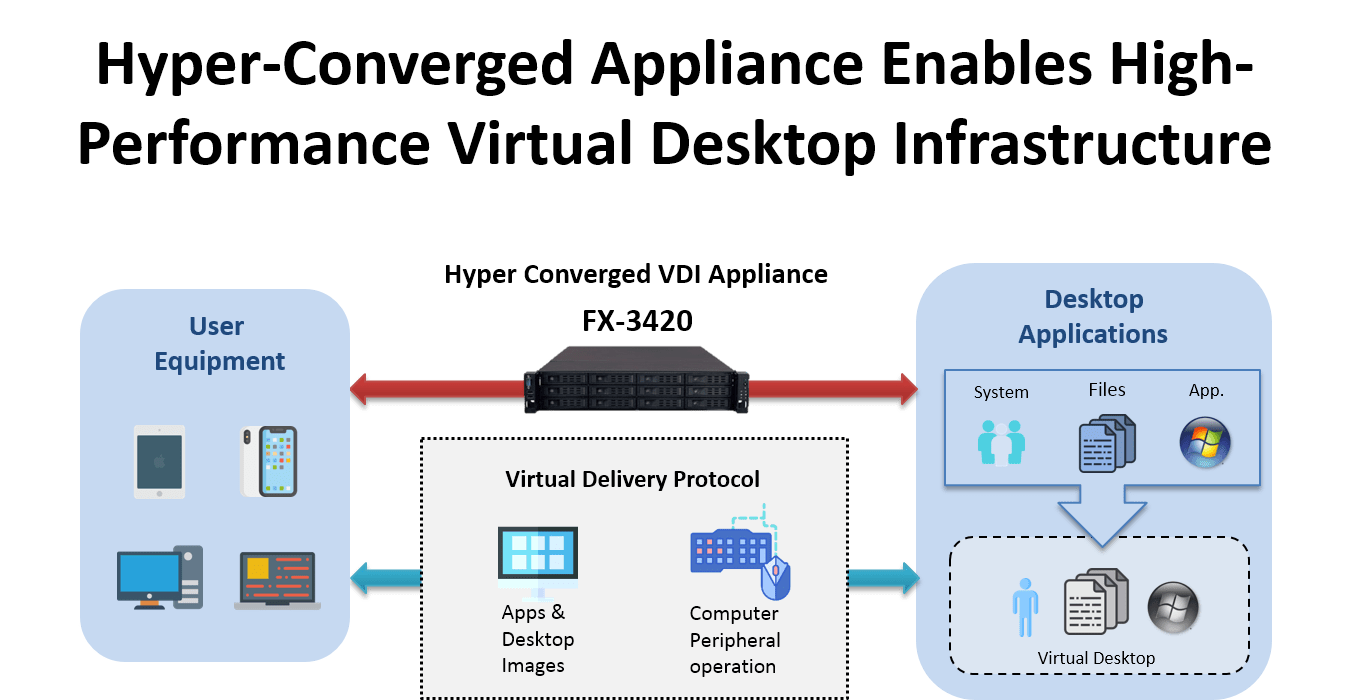Background
The growing use of mobile devices at work has contributed to the transformation of enterprise networks. One of the first dynamic trend was BYOD (bring your own device) as this concept offered significant economical benefits for enterprises. However, there are security and compatibility challenges. Therefore, VDI (virtual desktop infrastructure) has emerged to address new challenges in enterprise networking.
VDI is a centralized computing architecture with a hypervisor-enabled central server hosting desktop environments. In other words, desktop environment is virtualized like a VM (virtual machine) and users connect to the virtual desktop through thin client or mobile devices. Users can operate the operating system like on their PCs, but all the data is saved in the centralized server.
There are several significant benefits of VDI for both infrastructure owners and users. For users, since desktop is virtual, it functions like an OS image and they can just save the “image” and resume from where they have left. In this sense, desktop becomes “persistent”. This is particularly beneficial for fast-paced, highly-digitalized offices. For enterprises, they save tremendous costs in providing specific computing hardware. Secondly, there is no security issue in BYOD environment, since end client device does not possess any valuable data. Lastly, IT management no longer has to deal with the compatibility with various user devices in BYOD, because in VDI, the desktop is virtualized and user can connect to it through network.
Requirements
To meet the increasing demands in network virtualization in the business world, a China-based global leader in supplying infrastructure solutions cooperated with Lanner to develop a hyper-converged server to meet today’s VDI requirement. The joint platform needs to meet the following features:
High Performance Compute for Hyper-Converged VDI
In a VDI architecture, the central server hosts desktop environment for multiple end clients and all the data and app operation are all carried in the central server. Therefore, high performance compute is a must to assure QoS (quality of service)
High-Density Storage bays
As addressed earlier, all the data is saved in the central server under VDI architecture. Thus, it requires high-density storage to accommodate data from multiple end clients and operating system like Windows OS.
Expansion slots for vGPU acceleration card
PCI-Express expansion slots are important additions to the joint solution, so that the joint solution can be scalable for future upgrade, such as adding vGPU acceleration card.
High Availability
High-availability is critical as all end clients connect to the central server for desktop environment. In other shorts, the joint solution has to ensure constant uptimes.

Solutions
In this collaboration, Lanner presented FX-3420, a secure, high-performance, and high storage density server in 2RU of space to realize VDI and HCI infrastructure. FX-3420 is powered by dual 2nd Gen Intel® Xeon® Scalable SP processor family up to 205w and up to 768GB of memory through multiple DDR4 2666 MHz REG DIMM modules. For high-density storage, FX-3420 offers 12x SATA 3.5” hot-swappable disk drive bays and 2 x hot-swappable SATA 2.5” hot-swappable bays at rear.
For expansion purpose, FX-3420 is designed with 2x PCI-E by 16 (Max.266.7 mm) + 1 x PCIE by 8 HH/HL expansion sockets for module additions, such as vGPU acceleration card. As a high-availability server, FX-3420 is built with 850W 1+1 redundant power supply.
Related Articles
- Virtual Desktop Infrastructure (VDI) Comes in Handy to Help Through Remote Workforce Transition
- Virtual Desktop Infrastructure (VDI) in the Post-COVID-19 World




